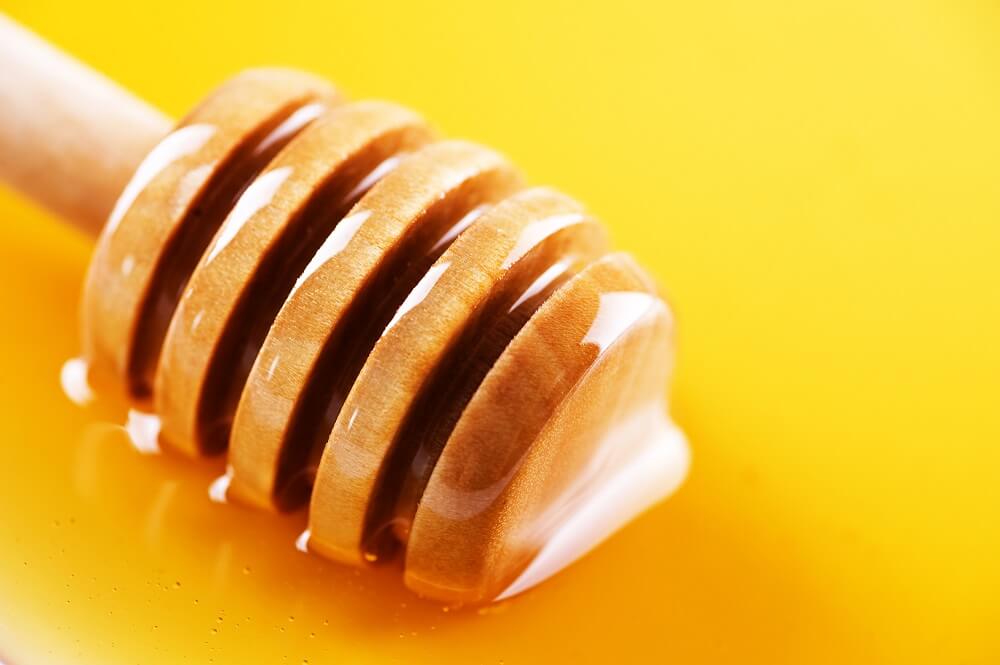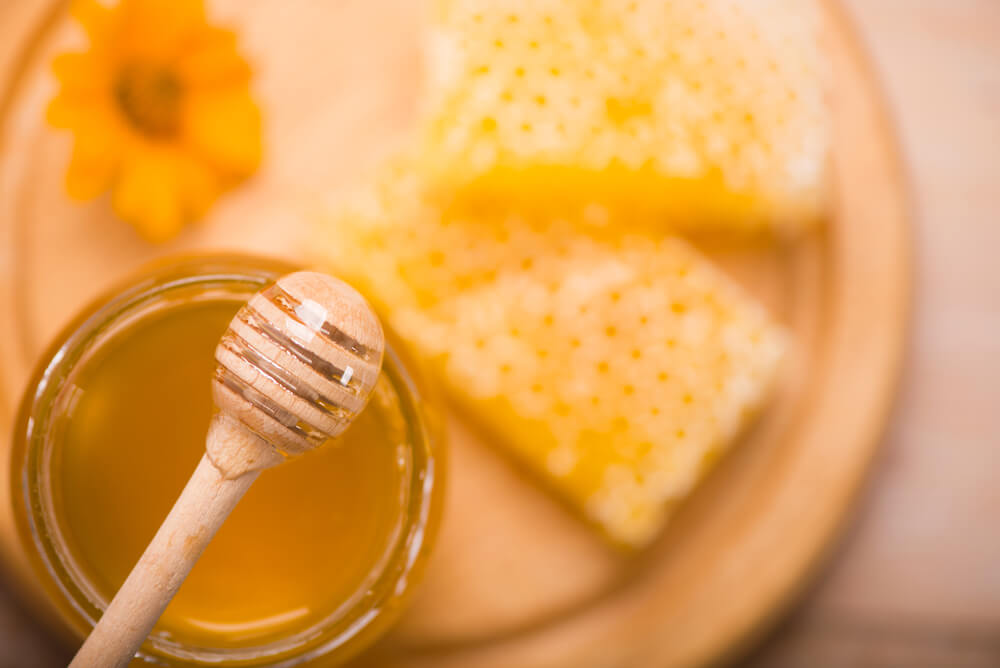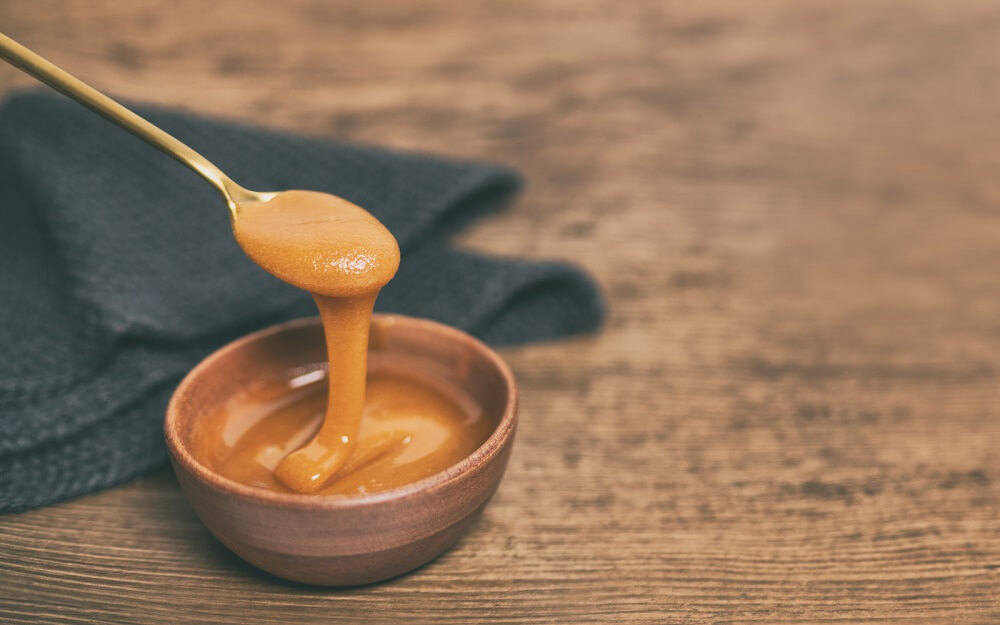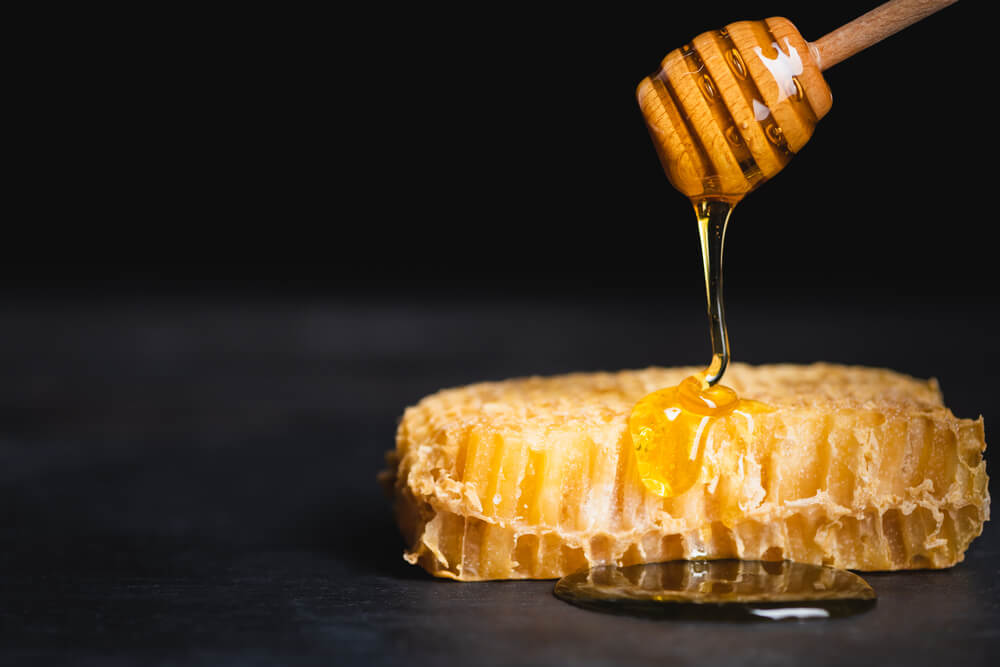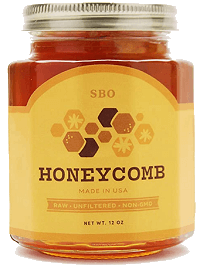What is Sage Honey?
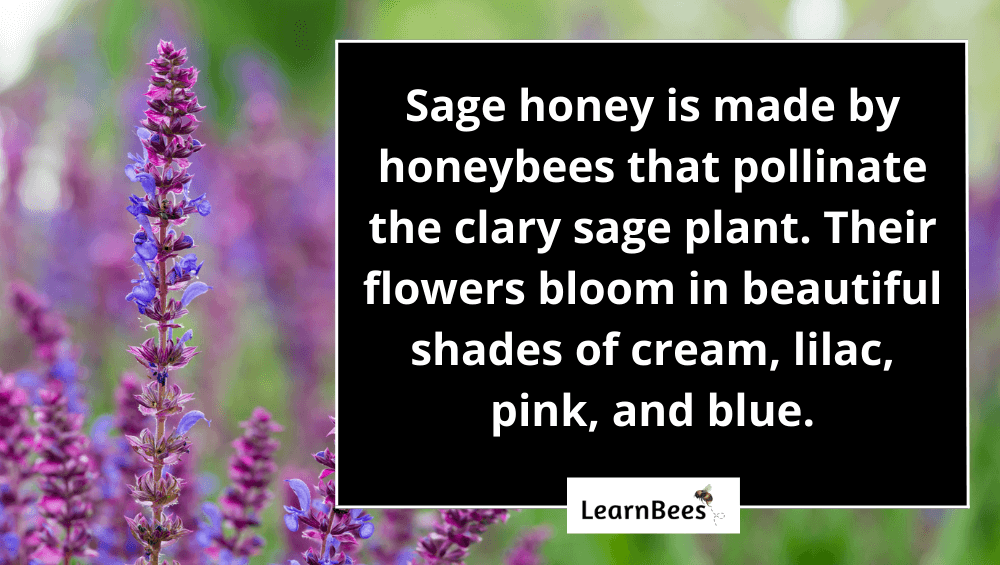
Sage honey is produced by honeybees that feed on the clary sage plant.
The clary sage plant (Salvia sclarea) is native to the Mediterranean and parts of Europe. The plant is easy to grow and adds a gorgeous display of flowers to any landscape.(1)
Best of all?
The honey that comes from sage plants is delicious.
Raw sage honey has a balanced flavor that isn’t overpowering. It’s sweet with subtle floral undertones. The first thing you’ll notice when opening the jar is the delicious aroma of sage honey.
There’s nothing else like it.
Even better?
Sage honey crystallizes more slowly than other honey types.
Crystallization is a natural process where honey gradually transforms from a liquid to a solid. Once the honey crystallizes, you have to heat it to liquefy it again.
Fortunately, sage honey resists crystallization much longer than other types of honey.
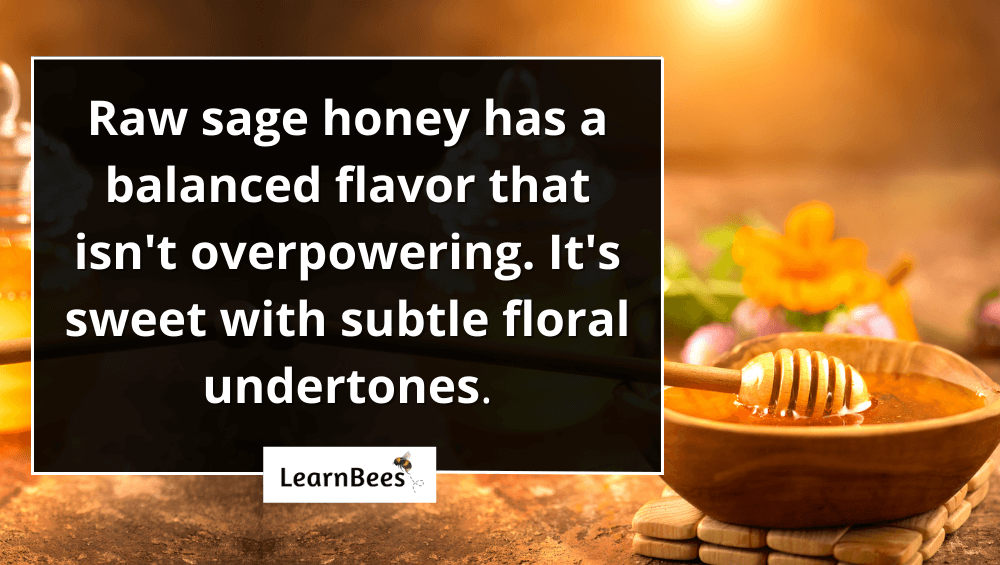
But there’s something we should tell you first.
Sage honey has anti-bacterial, anti-inflammatory, and antifungal effects that make it a superfood. But, these health benefits only come from raw honey.(2)
Raw sage honey is honey straight from the beehive. It hasn’t been heated or processed.
But why should you care?
Because some companies process their honey to the point where it no longer qualifies as real honey.
Honey is heated during pasteurization, which removes essential antioxidants and enzymes. This can reduce the honey’s effectiveness in treating sore throats, coughs, and skin injuries.(3, 4)
And here’s the thing:
Artificial sweeteners, like high fructose corn syrup, are frequently used in processed honey. Because of this, the FDA warns against processed honey.(5)
But what makes raw honey different?
Raw sage honey hasn’t been heated, filtered, or combined with other ingredients. As a result, it keeps all the beneficial enzymes, antioxidants, and nutrients that make honey a superfood.
So as a rule of thumb:
Always look for honey labels that say “raw honey.” It’s far better than the low-budget honey in plastic bear containers.
What Are the Benefits of Sage Honey?
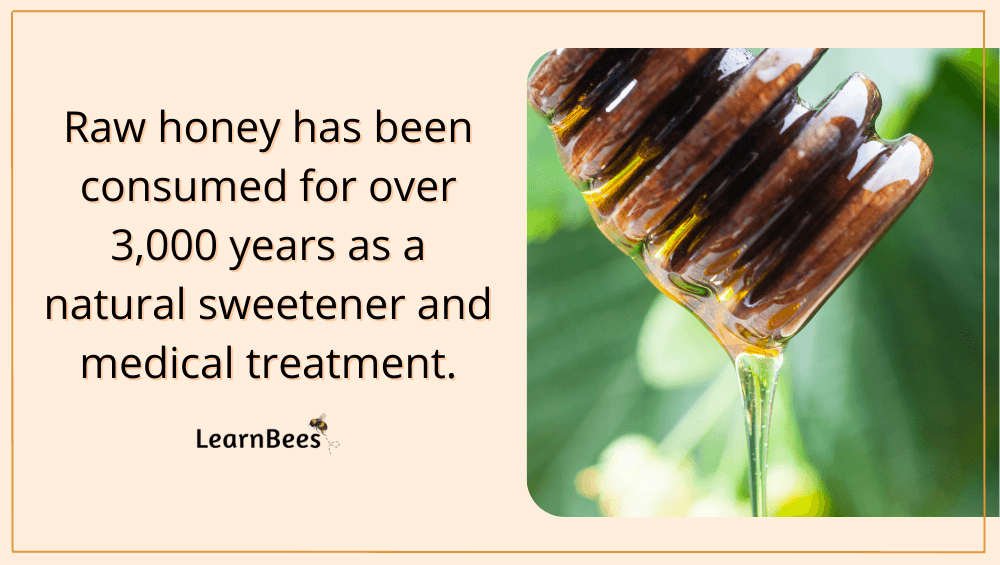
Raw honey has been consumed for thousands of years as a natural sweetener and medical treatment. In fact, honey usage dates back to ancient Egypt, where it was offered as a gift to gods and goddesses.
Sage Honey Nutrition
One tablespoon of this honey contains:
- Calories: 60 calories
- Protein: 0 grams
- Fat: 0 grams
- Carbs: 17 grams
- Sugars: 16 grams
So what are the sage honey benefits?
Let’s talk about a few.
Benefit 1: Honey has a High Antioxidant Content

Honey contains antioxidants, such as flavonoids and phenolic acids, that protect our bodies against cell damage. Damage to cells can lead to various conditions, including type 2 diabetes and heart disease.(6, 7)
Sage honey is high in antioxidants called flavonoids. A diet high in flavonoids can help you avoid chronic diseases such as heart disease and some types of cancer.(8, 9)
Raw honey’s antioxidants have anti-inflammatory effects that may assist with oxidative stress-related conditions.(10)
Honey has been discovered to effectively prevent the spread of lung cancer cells in test-tube studies.(11)
In several studies, raw honey has been found to benefit the respiratory, gastrointestinal, cardiovascular, and nervous systems.(12)
Benefit 2: Honey is Antibacterial
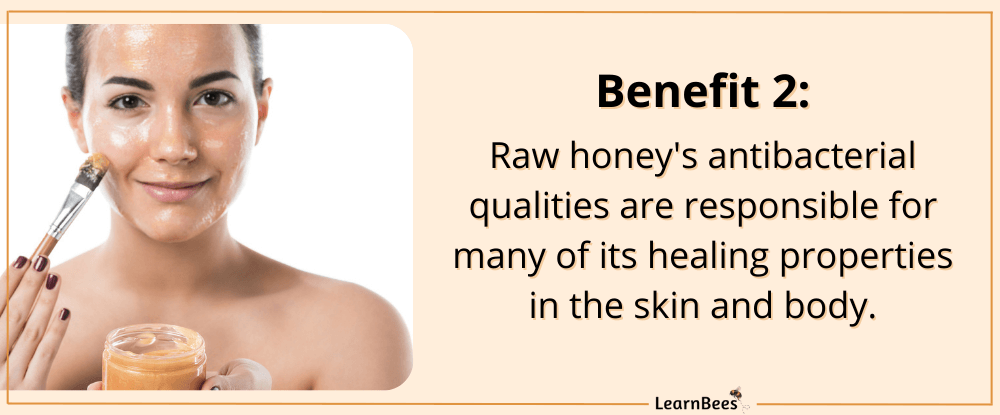
Honey has been proven to aid in healing wounds and infections that occur following surgery.(13)
The antibacterial properties of raw sage honey help explain its wide range of health benefits.
Honey includes chemicals that release hydrogen peroxide over time. Hydrogen peroxide is an acid that breaks down bacteria cell walls, effectively killing them.(14, 15)
Honey is beneficial in combating Staphylococcus aureus and Pseudomonas aeruginosa, both of which are antibiotic-resistant bacteria. Researchers discovered that honey’s high levels of hydrogen peroxide made it effective against these germs.(16)
Benefit 3: Honey Promotes Heart Health

Raw honey has been linked to a reduced risk of heart disease in several studies.
Regular consumption of honey was linked to a decreased risk of high blood pressure in one study of 4,500 people.(17)
According to some research, honey has had a beneficial impact on blood fat levels, heart function, and blood pressure.(18)
In a study on rats, honey protected the heart against oxidative stress.(19)
Propolis, a resin made by honeybees from sap-producing trees, is also present in raw honey. Propolis has cholesterol-lowering and triglyceride-lowering effects.(20)
Benefit 4: Honey Can Help with Sore Throats and Coughs

Coughing is a common issue among children with upper respiratory infections, and it may have a detrimental influence on both children’s sleep and parents’ sleep.
Fortunately, raw honey may be a good substitute for traditional cough medicines, according to research.(21)
Honey has shown to be more effective than some cough medicine ingredients, including diphenhydramine.(22)
Honey may also aid in the reduction of cough durations.
Honey has been found in various studies to help alleviate upper respiratory symptoms. It’s also been shown to help children and parents sleep better when they have coughs.(23, 24)
Unlike some cough medications, honey doesn’t have any adverse effects.
However, honey should not be given to infants under one year because of the risk of infant botulism.(25)
What Are the Risks of Sage Honey?
Sage honey is considered safe for the majority of people.
That said, you should be aware of these risks:
Risk 1: Honey Can Harm Babies under 12 Months Old

Honey is not suggested for babies because of infant botulism.
Botulism is a rare, food-borne illness caused by Clostridium botulinum bacteria. Botulism affects the nervous system and can result in respiratory failure and paralysis.
Honey is a leading cause of infant botulism. They cannot fight the bacteria because they don’t have a mature immune system yet.
With that in mind, honey is considered safe for people over the age of 12 months.
Risk 2: Honey May Raise Blood Sugar Levels in Diabetics

Sage honey might raise blood sugar levels in people with diabetes.
While sage honey does have health advantages, it’s important to remember that it also contains sugar and carbohydrates. During the day, people with diabetes must carefully regulate their carbohydrates, especially while using insulin.
Honey and sugar should be consumed in moderation since they raise blood sugar levels.
FAQs on Sage Honey
- What color is sage honey?
- How do you take sage honey?
- Does sage honey crystallize?
- What is sage honey good for?
- Is sage honey in tea good?
- Is sage honey vegan?
- What is the taste of sage honey?
- Is sage honey pure honey?
- Does sage honey come from bees?
- Can you buy sage honey with honeycomb?
- Can sage honey be used for weight loss?
- Is sage honey safe?
- Is sage honey beneficial to the skin?
- Where can I buy sage honey?
- How do you make sage honey?
- What’s the difference between sage honey vs. wildflower honey?
What color is sage honey?
Sage honey is typically light golden or light amber. It’s much lighter in color than some honey varieties, such as buckwheat honey.
—> Go back to the FAQs on sage honey
More to Explore:
How do you take sage honey?
People sometimes ask, “How do you use sage honey?”
Sage honey can be used in several ways. It can be eaten straight from the jar or added to tea, yogurt, oatmeal, or other food. Honey pairs well with many foods, so it’s fun to get creative.
One of my favorite ways to eat sage honey is by mixing a spoonful with my tea. I also like to add a dollop to my oatmeal in the morning for extra sweetness.
—> Go back to the FAQs on sage honey
More to Explore:
Does sage honey crystallize?
Yes, sage honey can crystallize. All types of honey will eventually crystallize, but some more quickly than others.
Sage honey typically crystallizes slower than other types of honey. This is because it has a high fructose content, meaning the natural sugars stay dissolved longer. This prevents the honey from forming tiny crystals, thus remaining in liquid form for longer.
It’s important to mention:
Crystallization is a natural process and doesn’t affect the quality of the honey. Honey doesn’t expire when stored correctly.
—> Go back to the FAQs on sage honey
More to Explore:
- The Top 3 Best Manuka Honey Brands
- Orange Blossom Honey: Uses, Benefits, & Risks
- Sourwood Honey: Uses, Benefits, & Risks
What is sage honey good for? Is sage honey good for you?
Sage honey has many benefits. Some of the benefits are:
- Sage honey is good for coughs, sore throats, and the common cold.
- Sage honey is good for skin wounds, burns, and rashes.
- Sage honey has anti-inflammatory and antibacterial properties.
These benefits come from raw, unprocessed sage honey. Check the label before purchasing to ensure you’re getting raw honey.
—> Go back to the FAQs on sage honey
More to Explore:
Is sage honey in tea good?
Yes, sage honey in tea is a great way to enjoy the benefits of honey. As mentioned before, sage honey has anti-inflammatory and antibacterial properties. These can help soothe a sore throat or calm a cough.
To add honey to tea, simply stir in a spoonful or two to taste. The honey will dissolve in hot tea and combine nicely.
—> Go back to the FAQs on sage honey
More to Explore:
- The Brutally Honest Truth About Sour Honey
- Buckwheat Honey: Uses, Benefits, & Risks
- Can You Eat Honeycombs?
Is sage honey vegan?
No, honey isn’t vegan because it comes from bees. Vegans don’t consume any animal products, including honey.
—> Go back to the FAQs on sage honey
More to Explore:
What is the taste of sage honey?
People regularly ask, “Does sage honey taste like sage?”
Sage honey doesn’t taste like sage leaves. Instead, it has a mild sweetness with notes of floral and butterscotch. The taste of sage honey can vary slightly depending on the jar. This is because the honeybees collect nectar from sage plants from different regions.
—> Go back to the FAQs on sage honey
More to Explore:
Is sage honey pure honey?
Not all sage honey is pure. To get pure honey, you need to check for labels that say the honey is “raw.” This means it hasn’t been processed or heated, killing off some of the beneficial properties.
Raw honey is the purest form of honey. It’s the type of honey that local beekeepers typically sell.
—> Go back to the FAQs on sage honey
More to Explore:
Does sage honey come from bees?
Yes, sage honey comes from honeybees. Honeybees collect nectar from sage flowers to make honey. The nectar is a sugary liquid that the bees store in their hive.
The bees then fan their wings inside the hive, which evaporates some of the water from the nectar. This process turns the nectar into honey.
Once the honey is ready, the bees seal it up in wax to preserve it.
—> Go back to the FAQs on sage honey
More to Explore:
Can you buy sage honey with honeycomb?
Yes, sage honeycomb is delicious. The honeycomb is the beeswax that the honey is stored in. It’s edible and has a chewy texture. You can buy sage honeycomb online or from a local beekeeper.
—> Go back to the FAQs on sage honey
More to Explore:
- What is Longan Honey?
- Do Honey Pasteurization Ruin Honey?
- Allergic to Honey: Signs of a Honey Allergy + Treatment
Can sage honey be used for weight loss?
Honey is high in sugar and carbs, so it isn’t typically recommended for weight loss. People who are trying to lose weight should consume honey in moderation.
—> Go back to the FAQs on sage honey
More to Explore:
- Honey for Skin Benefits: Directions, Uses, & Risks
- 8 Scientific Benefits of Raw Honey
- What Are Honeycombs Make Of?
Is sage honey safe?
Yes, sage honey is safe for most people. However, honey shouldn’t be given to babies under 12 months old because they can get infant botulism from the spores in honey.
Also, people with diabetes should be careful not to overconsume honey because it can cause spikes in blood sugar levels.
—> Go back to the FAQs on sage honey
More to Explore:
- Why is Manuka Honey So Expensive?
- Can You Eat Beeswax?
- Beeswax vs. Soy Wax: Which is Better for Candle Making?
Is sage honey beneficial to the skin?
Yes, there are several sage honey benefits for the skin. Raw honey has been used as a natural remedy for centuries. It’s known to have antibacterial and anti-inflammatory properties, which can help with skin conditions like acne, eczema, and psoriasis.
Honey can also be used as a natural face mask. Simply apply honey to the skin and leave it on for a few minutes before rinsing off.
—> Go back to the FAQs on sage honey
More to Explore:
Where can I buy sage honey?
Raw sage honey is available online and from some local beekeepers. Check the label to ensure you’re getting raw, unprocessed honey. This is the type of honey that has the most health benefits.
Honey can also be found in some health food stores. However, not all honey sold in stores is raw. So, be sure to read the label before purchasing.
—> Go back to the FAQs on sage honey
More to Explore:
- Fermented Garlic and Honey Recipe
- What’s the Difference Between Raw and Organic Honey?
- Cinnamon Honey: Are There Health Benefits?
How do you make sage honey?
Honey is made by bees, not humans. The process begins when the bees collect nectar from sage flowers. The nectar is a sugary liquid that the bees store in their hive.
The bees then fan their wings inside the hive, which evaporates some of the water from the nectar. This process turns the nectar into honey.
Once the honey is ready, the bees seal it up in wax to preserve it.
The final product is raw, unprocessed honey that contains all of the beneficial properties of the sage plant.
—> Go back to the FAQs on sage honey
More to Explore:
What’s the difference between sage honey vs. wildflower honey?
The main difference between sage honey and wildflower honey is the taste. Sage honey has a mild sweetness with notes of floral and butterscotch. On the other hand, wildflower honey is typically more fruity and robust in flavor.
Another difference is that sage honey is usually lighter in color, while wildflower honey can range from light to dark.
Sage honey is produced in limited quantities and is only available in certain areas, while wildflower honey is more widely available.
